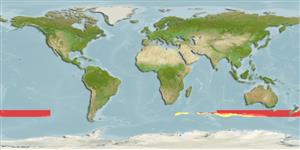Common names from other countries
Élasmobranches (requins et raies) (sharks and rays) >
Squaliformes (Sleeper and dogfish sharks) >
Somniosidae (Sleeper sharks)
Etymology: Scymnodalatias: scymno-, referring to previous placement in Scymnodon; dalatias, referring to lack of dorsal spines like most sharks in the family Dalatiidae (sometimes included within Somniosidae). (See ETYFish); albicauda: albus (L.), white; cauda (L.), tail, referring to white markings on caudal fin. (See ETYFish).
Environment: milieu / climate zone / depth range / distribution range
Écologie
marin bathypélagique; océanodrome (Ref. 51243); profondeur 150 - 510 m (Ref. 6871). Deep-water; 42°S - 50°S
Eastern Indian Ocean: southern Australia. Southwest Pacific: New Zealand.
Taille / Poids / Âge
Maturity: Lm ? range ? - ? cm
Max length : 111 cm TL mâle / non sexé; (Ref. 26346)
Description synthétique
Morphologie | Morphométrie
Épines dorsales (Total): 0. Grey and white, mottled with large brown or black spots; tail mostly white with black tips (Ref. 26346). Dorsal fins small, pectoral fins angular, and an asymmetric caudal fin with a dark-tipped upper lobe (Ref. 6871).
Oceanic (Ref. 6871). A rare species known only from a few specimens taken by tuna longliners and trawlers (Ref. 6871). Ovoviviparous (Ref. 205), with at least 59 young in a litter (Ref. 26346).
Life cycle and mating behavior
Maturité | Reproduction | Frai | Œufs | Fécondité | Larves
Probably ovoviviparous (Ref. 6871), with at least 59 young (Ref. 26346). Distinct pairing with embrace (Ref. 205).
Last, P.R. and J.D. Stevens, 1994. Sharks and rays of Australia. CSIRO, Australia. 513 p. (Ref. 6871)
Statut dans la liste rouge de l'IUCN (Ref. 130435)
CITES (Ref. 128078)
Not Evaluated
Menace pour l'homme
Harmless
Utilisations par l'homme
Plus d'informations
Taille/ÂgeCroissanceLongueur-poidsLongueur-longueurFréquences de longueursMorphométrieMorphologieLarvesDynamique des populations larvairesRecrutementAbondance
RéférencesAquacultureProfil d'aquacultureSouchesGénétiqueElectrophoresesHéritabilitéPathologiesTraitementMass conversion
CollaborateursImagesStamps, Coins Misc.SonsCiguateraVitesseType de nageSurface branchialeOtolithesCerveauxVision
Outils
Articles particuliers
Télécharger en XML
Sources Internet
Estimates based on models
Preferred temperature (Ref.
115969): 7.2 - 11.8, mean 9.2 (based on 20 cells).
Phylogenetic diversity index (Ref.
82804): PD
50 = 0.5625 [Uniqueness, from 0.5 = low to 2.0 = high].
Bayesian length-weight: a=0.00389 (0.00168 - 0.00901), b=3.13 (2.94 - 3.32), in cm Total Length, based on LWR estimates for this (Sub)family-body shape (Ref.
93245).
Niveau trophique (Ref.
69278): 4.1 ±0.5 se; based on size and trophs of closest relatives
Résilience (Ref.
120179): Faible, temps minimum de doublement de population : 4,5 à 14 années (Fec=59).
Fishing Vulnerability (Ref.
59153): High to very high vulnerability (67 of 100).
